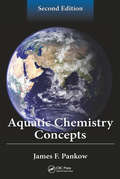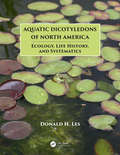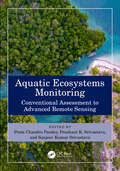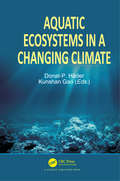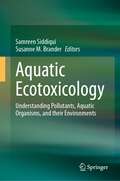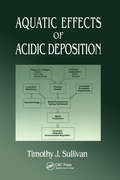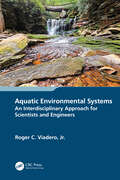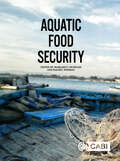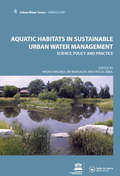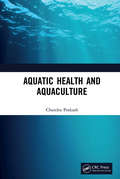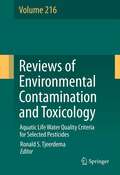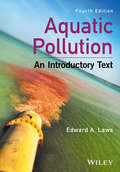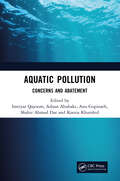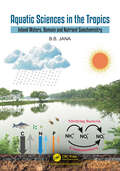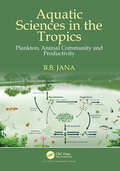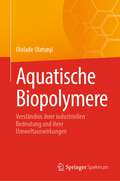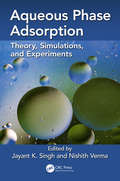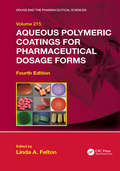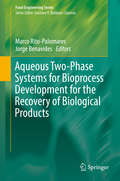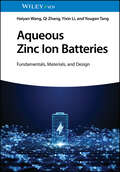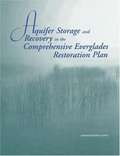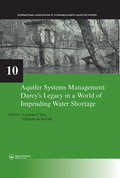- Table View
- List View
Aquatic Chemistry Concepts, Second Edition
by James PankowAquatic Chemistry Concepts, Second Edition, is a fully revised and updated textbook that fills the need for a comprehensive treatment of aquatic chemistry and covers the many complicated equations and principles of aquatic chemistry. It presents the established science of equilibrium water chemistry using the uniquely recognizable, step-by-step Pankow format, which allows a broad and deep understanding of aquatic chemistry. The text is appropriate for a wide audience, including undergraduate and graduate students, industry professionals, consultants, and regulators. Every professional using water chemistry will want this text within close reach, and students and professionals alike will expect to find at least one copy on their library shelves. Key Features Extremely thorough, one-of-a-kind treatment of aquatic chemistry Discussions of how to carry out complex calculations regarding the chemistry of lakes, rivers, groundwater, and seawater Numerous example problems worked in complete detail Special foreword by Jerry L. Schnoor
Aquatic Dicotyledons of North America: Ecology, Life History, and Systematics
by Donald H. LesAquatic Dicotyledons of North America: Ecology, Life History, and Systematics brings together a wealth of information on the natural history, ecology, and systematics of North American aquatic plants. Most books on aquatic plants have a taxonomic focus and are intended primarily for identification. Instead, this book provides a comprehensive overview of the biology of major aquatic species by compiling information from numerous sources that lie scattered among the primary literature, herbarium databases, and other reference materials. Included dicotyledon species are those having an obligate (OBL) wetland status, a designation used in the USACE National Wetland Plant List. Recent phylogenetic analyses are incorporated and rationale is provided for interpreting this information with respect to species relationships. This diverse assemblage of information will be useful to a wide range of interests including academic researchers, wildlife managers, students, and virtually anyone interested in the natural history of aquatic and wetland plants. Although focusing specifically on North America, the cosmopolitan distribution of many aquatic plants should make this an attractive text to people working virtually anywhere outside of the region as well. This book is an essential resource for assisting with wetland delineation.
Aquatic Ecosystems Monitoring: Conventional Assessment to Advanced Remote Sensing
by Prem Chandra Pandey, Prashant K. Srivastava, and Sanjeev Kumar SrivastavaThis book collates traditional and modern applications of remote sensing in aquatic ecosystem monitoring. It covers conventional assessment methods like sampling, surveying, macroinvertebrates, and chlorophyll estimation for aquatic ecosystem health assessment. Advanced remote sensing technology provides timely spectral information for quantitative and qualitative assessment of water quality, shoreline changes, coral bleaching, and vegetation monitoring. The book covers different types of aquatic ecosystems like wetlands, rivers, lakes, saline, and the brackish lake. It also: Reviews the latest applications of remote sensing in the monitoring and assessment of aquatic ecosystems Includes traditional methods like cartography, sampling, surveying, phytoplankton assessment, river interlinking, and chlorophyll estimation Discusses the application of multi-source data and machine learning in monitoring aquatic ecosystems Discusses aquatic ecosystem management, services, threats, and sustainability Explores challenges, opportunities, and prospects of future Earth observation applications for aquatic ecosystem monitoring The book discusses space-borne, airborne, and drone geospatial data. The parts broadly cover aquatic ecosystem monitoring, vegetation management, advanced modeling practices, and challenges. It is meant for scientists, professionals, and policymakers working in environmental sciences, remote sensing, and geology.
Aquatic Ecosystems in a Changing Climate
by Donat-P Häder Kunshan GaoGlobal climate change affects productivity and species composition of freshwater and marine aquatic ecosystems by raising temperatures, ocean acidification, excessive solar UV and visible radiation. Effects on bacterioplankton and viruses, phytoplankton and macroalgae have farreaching consequences for primary consumers such as zooplankton, invertebrates and vertebrates, as well as on human consumption of fish, crustaceans and mollusks. It has affected the habitation of the Arctic and Antarctic oceans the most so far. Increasing pollution from terrestrial runoff, industrial, municipal and household wastes as well as marine transportation and plastic debris also affect aquatic ecosystems.
Aquatic Ecotoxicology: Understanding Pollutants, Aquatic Organisms, and their Environments
by Samreen Siddiqui Susanne M. BranderThis textbook offers a basic understanding of aquatic ecotoxicology from molecular to physiological levels for graduate and advanced undergraduate students. The book covers the guidelines and lab protocols used by international organizations for ecotoxicology studies, and discusses the challenges faced by aquatic organisms in a changing climate from an ecotoxicological perspective. Readers will learn about pollutants, contaminants and chemicals of emerging concern (CECs) in aquatic environments, their impacts on environmental and human health, and what techniques can be used to curb and control their adverse impacts. The book will be useful for students in aquatic ecotoxicology, environmental pollution and marine biochemistry.
Aquatic Effects of Acidic Deposition
by Timothy J SullivanThe completion of the initial phase of the U.S. National Acid Precipitation Assessment Program (NAPAP) in 1990 marked the end of the largest environmental research and assessment effort to that time. The resulting series of 27 State of Science and Technology (SOS/T) Reports and the NAPAP Integrated Assessment represent a decade of work by hundreds
Aquatic Environmental Systems – an Interdisciplinary Approach for Scientists and Engineers
by Roger C. Viadero, Jr.Considering that environmental science draws students and practitioners with widely varied backgrounds, there is a need for materials that help readers to grow their knowledge of fundamental principles from chemistry, physics, and biology to understand, describe, and predict the ways in which constituents (sediment, nutrients, organic matter, etc.) interact and move in aquatic systems (rivers, lakes, groundwater, and the atmosphere). Aquatic Environmental Systems: An Interdisciplinary Approach for Scientists and Engineers focuses on developing a common vocabulary and a rigorous material balance-based approach to understanding these movements and interactions. It examines the key properties of water and the ways they impact the behavior of water in the environment, providing a focused enumeration of those aspects of water structure that have direct and profound impacts on aquatic environmental systems. Features: Provides open-ended exercises to allow students to tailor work to their personal local/regional interests. Focuses on conveying understanding of the underlying principles and assumptions/limitations which are frequently underemphasized or overlooked entirely in other books. Deemphasizes straight memorization while focusing on methods that can be applied to more broad-based problem solving. Accommodates a wide range of mathematics skills and backgrounds.
Aquatic Food Quality and Safety Assesment Methods
by G. Jeyasekaran R. Jeya ShakilaThe book explains on the methods and procedures adopted for testing the quality and safety of aquatic food products. The analytical techniques available for testing the chemical constituents of aquatic food with separate chapters on the analysis of lipids, proteins, vitamins, and minerals are exhaustively given to determine their nutritional quality. The various methods for sensory, physical, biochemical and microbiological quality assessments of aquatic food are explicitly given with detailed protocols for easy adoption. Special chapters covering the chemical contaminants and permitted additives for residue monitoring are dealt, as they are important food safety requirements. This book will be very helpful for the food quality control technologists, food analysts, research scholars, and fisheries professionals as a holistic guide on a variety of testing procedures for facile adoption to meet the food safety and quality regulatory requirements. Note: T& F does not sell or distribute the Hardback in India, Pakistan, Nepal, Bhutan, Bangladesh and Sri Lanka.
Aquatic Food Security
by Margaret Crumlish Rachel NormanAquatic Food Security explores a range of issues related to this subject using global examples to illustrate both the strengths and weaknesses within the existing aquatic food supply chain. This is already an area of vital importance, and it will increase in importance as the aquaculture industry grows for the foreseeable future. The book addresses: - the role of intensification in global aquaculture production; - the importance of nutrition and selective breeding; - diseases and public health considerations; - the role of markets and of processing; - retail sectors; and - quality issues in our global seafood.
Aquatic Habitats in Sustainable Urban Water Management: Urban Water Series - UNESCO-IHP
by Iwona Wagner; Jiri Marsalek; Pascal BreilAquatic habitats supply a wide range of vital ecosystem benefits to cities and their inhabitants. The unsustainable use of aquatic habitats, including inadequate urban water management itself, however, tends to alter and reduce their biodiversity and therewith diminish their ability to provide clean water, protect us from waterborne diseases and po
Aquatic Health and Aquaculture
by Chandra PrakashThis book discusses how to use the wastewaters, liquid biowastes and soils unfit for agriculture to economically viable aquaculture practices; and putting the emphasis on, aquaculture posology, the science of quantification and administration of doses in aquatic health and aquaculture management. Broadly, aquaculture practices come across three types of problems each; in the context of water quality, and fin fish and shell fish diseases; and preventive, curative and noncurative diseases in fin fish and shell fish. Note: T&F does not sell or distribute the Hardback in India, Pakistan, Nepal, Bhutan, Bangladesh and Sri Lanka.
Aquatic Life Water Quality Criteria for Selected Pesticides (Reviews of Environmental Contamination and Toxicology #216)
by Ronald S. TjeerdemaReviews of Environmental Contamination and Toxicology attempts to provide concise, critical reviews of timely advances, philosophy and significant areas of accomplished or needed endeavor in the total field of xenobiotics, in any segment of the environment, as well as toxicological implications.
Aquatic Macrophyte Risk Assessment for Pesticides
by Dave Arnold Jo Davies Fred Heimbach Lorraine Maltby Gertie Arts Christina Pickl Veronique PoulsenGiven the essential role that primary producers play in aquatic ecosystems, it is imperative that the potential risk of pesticides to the structure and functioning of aquatic plants is adequately assessed. An integration of regulatory and research information from key specialists in the area of environmental regulation, Aquatic Macrophyte Risk Asse
Aquatic Mesocosm Studies in Ecological Risk Assessment
by Robert L. GraneyA Special Publication of the Society of Environmental Toxicology and Chemistry (SETAC)Aquatic Mesocosm Studies in Ecological Risk Assessment discusses the methods currently used for conducting simulated field studies and provides a series of case histories in which mesocosm type studies have been used to assess the impact of pesticides on aquatic ecosystems. Specific chapters address the dosing and exposure components of such studies and how they influence experimental design. Advantages and disadvantages of various statistical designs are addressed in detail. Regulatory aspects of the design and interpretation of these studies are also covered. The book will be a superb reference for aquatic biologists, ecologists, toxicologists, environmental toxicologists, environmental chemists, and regulatory personnel.
Aquatic Pollution: An Introductory Text
by Edward A. LawsSince the publication of the third edition of Aquatic Pollution in 2000, there have been many major developments within the field in terms of research, regulations, and also large-scale catastrophes that have had a significant impact on the aquatic environment; the Deepwater Horizon oil spill and the Fukushima nuclear disaster have taken their toll, and research on ocean acidification has developed enormously over the last decade. Recognizing, controlling, and mitigating aquatic pollution on a global scale is one of the most important and most difficult challenges facing society today.Fully updated to reflect current understanding and discussing these major recent developments, this fourth edition of Aquatic Pollution covers every aspect of pollution associated with urban runoff, acid rain, sewage disposal, pesticides, oil spills, nutrient loading, and more. Case studies of major pollution sites, all original to this new edition, help to illustrate points made in general discussion.Offering unprecedented depth of coverage, and discussing both fresh and sea water environments, this unique text provides a key teaching and learning tool for courses in environmental science, zoology, oceanography, biology, and civil or sanitary engineering, as well as a vital book for government policy makers. It is also an excellent primer for policymakers and activists focused on environmental issues.
Aquatic Pollution: Concerns and Abatement
by Imtiyaz Qayoom Adnan Abubakr Anu Gopinath Shabir A. Dar Keezia KhurshidThis book discusses the sources, mechanism, impact and abatement of pollution in waterbodies and lays a base foundation for further research. In this book, readers will also get acquainted with the methods of decontamination of lakes by phytoremediation, pesticide removal techniques from lakes, toxic site reclamation and environmental sustainability using microbial aspects associated with clean-up of wastes.Based on the issues related to pollution of aquatic environments, the subject matter of this book includes: Nanoplastic Pollutants Affecting Fisheries Sector All Over the World Freshwater Floral Diversities as Pollution Indicators Radioactive Waste: Sources and Impact on Environment Environmental Sustainability Using Microbial Aspects Associated With Clearing Up Waste Nitrates and Phosphates: Boon or Bane for Waterbodies Print edition not for sale in South Asia (India, Sri Lanka, Nepal, Bangladesh, Pakistan and Bhutan)
Aquatic Sciences in the Tropics: Inland Waters, Domain and Nutrient Geochemistry
by B.B. JanaThe tropical environment is unique due to its geographic location, climatic features, intense solar radiation, high temperature, heavy precipitation, less seasonal variation, enhanced food and productivity, faster metabolism, ecological dynamics and co-evolutionary processes that favor niches for specialized species. It also provides the richest biodiversity with endemic fish species that support millions of people in rural areas. This book Aquatic Sciences in the Tropics: Inland Waters, Domain and Nutrient Geochemistry comprises nine primary chapters that address various topics. Chapter 1 covers topics such as Water as a Substance, Water as a Medium, Fundamentals of Global Water Distribution and Hydrologic Cycle, Economics of Water and Challenges; Chapter 2: The Environment, Tropical Environment, Concept of Biosphere and Aquatic Biome, Tropical Aquatic Bionetwork, Tropical Limnology; Chapter 3: Origin of Lakes, General Classification of Lakes, Tropical Lakes, Lake Morphometry, Morpho-Edaphic Index, Trophic State Index of Lakes, Wetlands, Mangroves; Chapter 4: Concept of Stream Order, Streams and Rivers, The River Continuum Concept, Physico-chemical and Biological Features of Streams, Adaptations of Hill Stream Fishes; Chapter 5: Light as an Entity, Thermal Regime, Thermal Stratification, Lake Mixing, Turnover and Circulation; Chapter 6: Sources of CO2 in Inland Waters, Hydrogen Ion Concentration, The CO2–CO3–HCO3 System, Alkalinity, Hardness; Chapter 7: Dissolved Oxygen, Oxidation and Reduction Potential; Chapter 8: Total Dissolved Solids, Dissolved Organic Carbon; Chapter 9: Origin of Atmospheric Gases, Carbon and Carbon Cycle, Nitrogen, Nitrogen Fixation, Ammonification, Nitrification and Comammox, Denitrification and Anammox, Phosphorus and Sulphur.It is anticipated that the academic community, students, teachers, instructors, researchers, colleges, universities, institutions, administrators, policy makers, public libraries and the general public with an interest in these topics will find this text to be a valuable source of information and provide in-depth knowledge.
Aquatic Sciences in the Tropics: Plankton, Animal Community and Productivity
by B. B. JanaThe anatomy of water, water as a substance, water as a medium, the principles of the hydrologic cycle, the economics of water, and challenges are all covered in the first chapter of this book. The horizon of the tropical world, the environment, particularly the tropical environment, aquatic biome, tropical aquatic bionetwork, concept of biosphere, and tropical limnology are all covered in the second chapter. The third chapter covers the following topics: the origins of lakes, general lake classification, tropical lakes, lake morphometry, morpho-edaphic index, trophic status index of lakes, wetlands, and mangroves in tropical regions. The lotic environment is the main topic of the fourth chapter, which also covers the idea of stream order, the differences between rivers and streams, the river continuum, physical, chemical, and biological characteristics, and adaptations of fish found in hill streams. Chapter five covers the prokaryota, cyanobacteria, freshwater biota, and water-adapted organisms. The sixth chapter focuses on the algal communities Xanthophyceae, Euglenophyceae, Bacillariophyceae, Chrysophyceae, Phaeophyceae (brown algae), and Chlorophyceae. The seventh and last chapter covers the following topics: Protozoa, Porifera, Rotifera, Coelenterata, Annelida, Arthropoda, Crustacea, Aquatic Insects, Mollusca, Echinodermata, and Brachiopodaa.
Aquatische Biopolymere: Verständnis ihrer industriellen Bedeutung und ihrer Umweltauswirkungen
by Ololade OlatunjiDieses Buch gibt einen umfassenden Überblick über die jüngsten Entwicklungen bei industriellen Anwendungen, Verarbeitungstechniken und Modifikationen von Polymeren aus marinen Quellen. Es führt den Leser systematisch in die Biomaterialien Chitin, Kollagen, Alginate, Cellulose und Polyester ein und stellt eine Verbindung zwischen ihrer industriellen Bedeutung und ihren Auswirkungen auf die Umwelt her. Das Buch verdeutlicht die Auswirkungen der industriellen Nutzung des aquatischen Systems für organische und anorganische Stoffe auf die Umwelt und vertieft das Verständnis der industriellen und wirtschaftlichen Bedeutung aquatischer Biopolymere. Darüber hinaus geht es um die Frage, wie die Erhaltung des aquatischen Lebens und das industrielle und wirtschaftliche Interesse an der Entwicklung biologisch abbaubarer Alternativen für Kunststoffe in Einklang gebracht werden können. Das Buch richtet sich daher an Wissenschaftler:innen aus den Bereichen Chemie, Material- und Polymerwissenschaften sowie Ingenieurwesen.
Aqueous Phase Adsorption: Theory, Simulations and Experiments
by Nishith Verma Jayant SinghThis book covers theoretical aspects of adsorption, followed by an introduction to molecular simulations and other numerical techniques that have become extremely useful as an engineering tool in recent times to understand the interplay of different mechanistic steps of adsorption. Further, the book provides brief experimental methodologies to use, test, and evaluate different types of adsorbents for water pollutants. Through different chapters contributed by accomplished researchers working in the broad area of adsorption, this book provides the necessary fundamental background required for an academician, industrial scientist or engineer to initiate studies in this area. Key Features Explores fundamentals of adsorption-based separation Provides physical insight into aqueous phase adsorption Includes theory, molecular and mesoscopic level simulation techniques and experiments Describes molecular simulations and lattice-Boltzmann method based models for aqueous phase adsorption Presents state-of-art experimental works particularly addressing removal of "emerging pollutants" from aqueous phase
Aqueous Polymeric Coatings for Pharmaceutical Dosage Forms (Drugs and the Pharmaceutical Sciences)
by Linda A. FeltonAqueous-based film coating has become routine in the pharmaceutical industry. This process eliminates the use of organic solvents and thus avoids economic, environmental, and toxicological issues related to residual solvents and solvent recovery. Aqueous-based coating, however, is complex and many variables may impact the final product and its performance. This fourth edition of Aqueous Polymeric Coatings for Pharmaceutical Dosage Forms aims to provide insight into the factors and parameters that should be considered and controlled for the successful development and commercialization of a coated product. The fourth edition has been revised and expanded to reflect the most recent scientific advancements from the literature. The contributing authors explain in detail, using illustrated examples, appropriate steps to solve and ideally avoid formulation, processing, and stability problems and to achieve an optimized dosage form. Trade names and chemical names of commercially marketed coatings are used throughout the text to help familiarize the reader with the various materials available for pharmaceutical applications. This book will be a valuable resource for anyone in the pharmaceutical industry working in the area of aqueous-based film coating.
Aqueous Two-Phase Systems for Bioprocess Development for the Recovery of Biological Products (Food Engineering Series)
by Marco Rito-Palomares Jorge BenavidesThis comprehensive and unique text presents a full overview of downstream processing useful for those new to the concept as well as professionals with experience in the area. The history and theoretical principles of Aqueous Two-Phase Systems (ATPS) are covered in depth. Information on ATPS characterization and application is included, and ATPS equilibria and system parameters that have significant effect on partition behavior are studied. Aqueous Two-Phase Systems for Bioprocess Development for the Recovery of Biological Products addresses specific applications of ATPS for the recovery and partial purification of high molecular weight compounds such as proteins, nucleic acids and polysaccharides, particulate bioproducts such as cells and organelles and low molecular weight compounds. Non-conventional strategies involving ATPS such as affinity systems, continuous liquid-liquid fractionation stages and the recovery from plant extracts are presented. Economic analysis of the application of ATPS in comparison to other fractionation techniques, particularly liquid chromatography, is considered, as are opportunity and current trends in the ATPS research area. Each chapter utilizes the contributors' experimental expertise in traditional and non-conventional ATPS strategies, as well as analysis of areas of opportunity and perspectives on the development and future applications of ATPS in both the lab and larger scale operations. The result is a thorough and singular overview of ATPS which has not been matched by any other text on the market.
Aqueous Zinc Ion Batteries: Fundamentals, Materials, and Design
by Haiyan Wang Qi Zhang Yougen Tang Yixin LiAqueous Zinc Ion Batteries Pioneering reference book providing the latest developments and experimental results of aqueous zinc ion batteries Aqueous Zinc Ion Batteries comprehensively reviews latest advances in aqueous zinc ion batteries and clarifies the relationships between issues and solutions for the emerging battery technology. Starting with the history, the text covers essentials of each component of aqueous zinc ion batteries, including cathodes, anodes, and electrolytes, helping readers quickly attain a foundational understanding of the subject. Written by three highly qualified authors with significant experience in the field, Aqueous Zinc Ion Batteries provides in-depth coverage of sample topics such as: History, main challenges, and zinc metal anodes for aqueous zinc ion batteriesElectrochemical reaction mechanism of aqueous zinc ion batteries and interfacial plating and stripping on zinc anodesCathode materials for aqueous zinc ion batteries, covering manganese-based materials, vanadium-based materials, Prussian blue analogs, and other cathode materialsDevelopment of electrolytes, issues, and corresponding solutions for aqueous zinc ion batteries Separators for aqueous zinc ion batteries, development of full zinc ion batteries, and future perspectives on the technology A detailed resource on a promising alternative to current lithium-ion battery systems, Aqueous Zinc Ion Batteries is an essential read for materials scientists, electrochemists, inorganic chemists, surface chemists, catalytic chemists, and surface physicists who want to be on the cutting edge of a promising new type of battery technology.
Aquifer Storage and Recovery in the Comprehensive Everglades Restoration Plan: A Critique of the Pilot Projects and Related Plans for ASR in the Lake Okeechobee and Western Hillsboro Areas
by National Research CouncilA report on Aquifer Storage and Recovery in the Comprehensive Everglades Restoration Plan.
Aquifer Systems Management: Selected Papers on Hydrogeology 10 (IAH - Selected Papers on Hydrogeology)
by Laurence Chery Ghislain De MarsilyPresented at the International Association of Hydrogeologists Dijon Symposium, this book contains 43 selected papers, grouped into six topics, that address the following issues: large aquifers, resource assessment; large aquifers, water salinity and evolution; karstic and carbonate aquifer systems; geothermal aquifer systems; aquifer contamination studies; and aquifer monitoring systems and management. In celebration of the 150th anniversary of the publication of Darcy's Law, the volume includes a summary of Darcy's life and his contribution to science, and five invited contributions on modern methods to estimate the hydraulic conductivity of aquifers.
